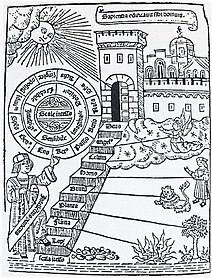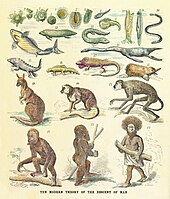
Aristotle was an Ancient Greek philosopher and polymath. His writings cover a broad range of subjects spanning the natural sciences, philosophy, linguistics, economics, politics, psychology, and the arts. As the founder of the Peripatetic school of philosophy in the Lyceum in Athens, he began the wider Aristotelian tradition that followed, which set the groundwork for the development of modern science.
In biology, taxonomy is the scientific study of naming, defining (circumscribing) and classifying groups of biological organisms based on shared characteristics. Organisms are grouped into taxa and these groups are given a taxonomic rank; groups of a given rank can be aggregated to form a more inclusive group of higher rank, thus creating a taxonomic hierarchy. The principal ranks in modern use are domain, kingdom, phylum, class, order, family, genus, and species. The Swedish botanist Carl Linnaeus is regarded as the founder of the current system of taxonomy, as he developed a ranked system known as Linnaean taxonomy for categorizing organisms and binomial nomenclature for naming organisms.

Natural history is a domain of inquiry involving organisms, including animals, fungi, and plants, in their natural environment, leaning more towards observational than experimental methods of study. A person who studies natural history is called a naturalist or natural historian.
The history of zoology before Charles Darwin's 1859 theory of evolution traces the organized study of the animal kingdom from ancient to modern times. Although the concept of zoology as a single coherent field arose much later, systematic study of zoology is seen in the works of Aristotle and Galen in the ancient Greco-Roman world. This work was developed in the Middle Ages by Islamic medicine and scholarship, and in turn their work was extended by European scholars such as Albertus Magnus.

The history of biology traces the study of the living world from ancient to modern times. Although the concept of biology as a single coherent field arose in the 19th century, the biological sciences emerged from traditions of medicine and natural history reaching back to Ayurveda, ancient Egyptian medicine and the works of Aristotle, Theophrastus and Galen in the ancient Greco-Roman world. This ancient work was further developed in the Middle Ages by Muslim physicians and scholars such as Avicenna. During the European Renaissance and early modern period, biological thought was revolutionized in Europe by a renewed interest in empiricism and the discovery of many novel organisms. Prominent in this movement were Vesalius and Harvey, who used experimentation and careful observation in physiology, and naturalists such as Linnaeus and Buffon who began to classify the diversity of life and the fossil record, as well as the development and behavior of organisms. Antonie van Leeuwenhoek revealed by means of microscopy the previously unknown world of microorganisms, laying the groundwork for cell theory. The growing importance of natural theology, partly a response to the rise of mechanical philosophy, encouraged the growth of natural history.

In Christianity, angels are the messengers of God.
Spiritual evolution, also called higher evolution, is the idea that the mind or spirit, in analogy to biological evolution, collectively evolves from a simple form dominated by nature, to a higher form dominated by the spiritual or divine. It is differentiated from the "lower" or biological evolution.
The Transmutation of species and transformism are 18th and early 19th-century ideas about the change of one species into another that preceded Charles Darwin's theory of evolution through natural selection. The French Transformisme was a term used by Jean Baptiste Lamarck in 1809 for his theory, and other 18th and 19th century proponents of pre-Darwinian evolutionary ideas included Denis Diderot, Étienne Geoffroy Saint-Hilaire, Erasmus Darwin, Robert Grant, and Robert Chambers, the anonymous author of the book Vestiges of the Natural History of Creation. Such ideas were associated with 18th century ideas of Deism and human progress. Opposition in the scientific community to these early theories of evolution, led by influential scientists like the anatomists Georges Cuvier and Richard Owen, and the geologist Charles Lyell, was intense. The debate over them was an important stage in the history of evolutionary thought and influenced the subsequent reaction to Darwin's theory.

Systema Naturae is one of the major works of the Swedish botanist, zoologist and physician Carl Linnaeus (1707–1778) and introduced the Linnaean taxonomy. Although the system, now known as binomial nomenclature, was partially developed by the Bauhin brothers, Gaspard and Johann, Linnaeus was first to use it consistently throughout his book. The first edition was published in 1735. The full title of the 10th edition (1758), which was the most important one, was Systema naturæ per regna tria naturæ, secundum classes, ordines, genera, species, cum characteribus, differentiis, synonymis, locis or translated: "System of nature through the three kingdoms of nature, according to classes, orders, genera and species, with characters, differences, synonyms, places".
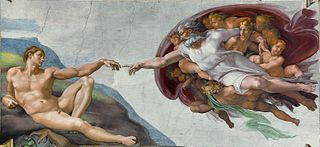
Islamic views on evolution are diverse, ranging from theistic evolution to Old Earth creationism. Some Muslims around the world believe "humans and other living things have evolved over time", yet some others believe they have "always existed in present form". Some Muslims believe that the processes of life on Earth started from one single point of species with a mixture of water and a viscous clay-like substance. Muslim thinkers have proposed and accepted elements of the theory of evolution, some holding the belief of the supremacy of God in the process. Some scholars suggested that both narratives of creation and of evolution, as understood by modern science, may be believed by modern Muslims as addressing two different kinds of truth, the revealed and the empirical. Others argue that faith and science can be integrated and complement each other.
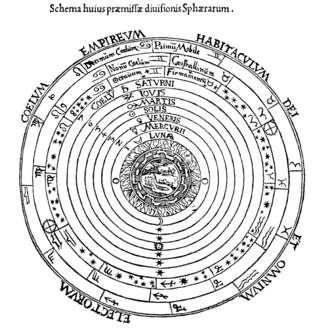
Nous, or Greek νοῦς, sometimes equated to intellect or intelligence, is a concept from classical philosophy for the faculty of the human mind necessary for understanding what is true or real.
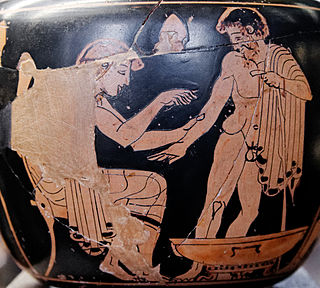
Ancient Greek medicine was a compilation of theories and practices that were constantly expanding through new ideologies and trials. The Greek term for medicine was iatrikē. Many components were considered in ancient Greek medicine, intertwining the spiritual with the physical. Specifically, the ancient Greeks believed health was affected by the humors, geographic location, social class, diet, trauma, beliefs, and mindset. Early on the ancient Greeks believed that illnesses were "divine punishments" and that healing was a "gift from the Gods". As trials continued wherein theories were tested against symptoms and results, the pure spiritual beliefs regarding "punishments" and "gifts" were replaced with a foundation based in the physical, i.e., cause and effect.

The Encyclopedia of the Brethren of Purity also variously known as the Epistles of the Brethren of Sincerity, Epistles of the Brethren of Purity and Epistles of the Brethren of Purity and Loyal Friends is an Islamic encyclopedia in 52 treatises (rasā'il) written by the mysterious Brethren of Purity of Basra, Iraq sometime in the second half of the 10th century CE. It had a great influence on later intellectual leading lights of the Muslim world, such as ibn Arabi, and was transmitted as far abroad within the Muslim world as al-Andalus.

The Muqaddimah, also known as the Muqaddimah of Ibn Khaldun or Ibn Khaldun's Prolegomena, is a book written by the historian Ibn Khaldun in 1377 which presents a view of universal history. Some modern thinkers view it as the first work dealing with the social sciences of sociology, demography, and cultural history. The Muqaddimah also deals with Islamic theology, historiography, the philosophy of history, economics, political theory, and ecology. It has also been described as a precursor or an early representative of social Darwinism, and Darwinism.
Contemporary debates about animal welfare and animal rights can be traced back to ancient history. Records from as early as the 6th century before the common era (BCE) include discussions of animal ethics in Jain and Greek texts. The relations between humans and nonnhumans are also discussed in the books of Exodus and Genesis, Jewish writings from the 6th or 5th century BCE.

Evolutionary thought, the recognition that species change over time and the perceived understanding of how such processes work, has roots in antiquity—in the ideas of the ancient Greeks, Romans, Chinese, Church Fathers as well as in medieval Islamic science. With the beginnings of modern biological taxonomy in the late 17th century, two opposed ideas influenced Western biological thinking: essentialism, the belief that every species has essential characteristics that are unalterable, a concept which had developed from medieval Aristotelian metaphysics, and that fit well with natural theology; and the development of the new anti-Aristotelian approach to modern science: as the Enlightenment progressed, evolutionary cosmology and the mechanical philosophy spread from the physical sciences to natural history. Naturalists began to focus on the variability of species; the emergence of palaeontology with the concept of extinction further undermined static views of nature. In the early 19th century prior to Darwinism, Jean-Baptiste Lamarck (1744–1829) proposed his theory of the transmutation of species, the first fully formed theory of evolution.
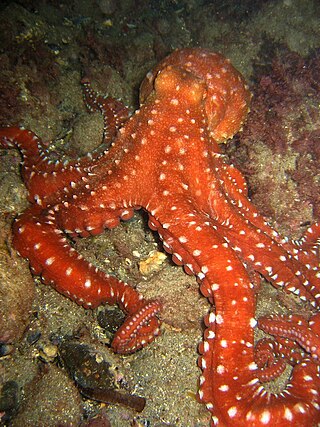
Aristotle's biology is the theory of biology, grounded in systematic observation and collection of data, mainly zoological, embodied in Aristotle's books on the science. Many of his observations were made during his stay on the island of Lesbos, including especially his descriptions of the marine biology of the Pyrrha lagoon, now the Gulf of Kalloni. His theory is based on his concept of form, which derives from but is markedly unlike Plato's theory of Forms.

"Missing link" is a hypothetical or recently-discovered transitional fossil. It is often used in popular science and in the media for any new transitional form. The term originated to describe the hypothetical intermediate form in the evolutionary series of anthropoid ancestors to anatomically modern humans (hominization). The term was influenced by the pre-Darwinian evolutionary theory of the Great Chain of Being and the now-outdated notion (orthogenesis) that simple organisms are more primitive than complex organisms.
Abū ʿAbd Allāh al-Mufaḍḍal ibn ʿUmar al-Juʿfī, died before 799, was an early Shi'i leader and the purported author of a number of religious and philosophical writings. A contemporary of the Imams Ja'far al-Sadiq and Musa al-Kazim (745–799), he belonged to those circles in Kufa whom later Twelver Shi'i authors would call ghulāt ('exaggerators') for their 'exaggerated' veneration of the Imams.
![1579 drawing of the Great Chain of Being from Didacus Valades [es], Rhetorica Christiana Great Chain of Being 2.png](http://upload.wikimedia.org/wikipedia/commons/thumb/b/b5/Great_Chain_of_Being_2.png/300px-Great_Chain_of_Being_2.png)

